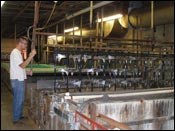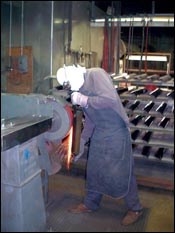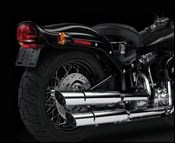Dedicated to Decorative
Adversity becomes opportunity for plating job shop
Valley City Plating (VCP) has been around a long time—the Grand Rapids, MI-based company began providing decorative finishing services to local furniture and other manufacturers in 1897.
VCP’s current owners, Jeff and Jon Rasche, acquired the company from their parents in 2002. Shortly after the current owners took over, they began experiencing problems with nickel/chrome plated parts for a major customer, Honda motorcycles.
The company currently operates out of an 82,000-ft2 facility, with approximately 70 employees performing buffing, polishing and decorative chrome plating of steel and brass parts for motorcycle OEMs such as Harley-Davidson and Honda. VCP also does work for furniture and gaming OEMs, and performs specialty finishing processes including antique, bright satin and satin brass and copper, black nickel and brushed chrome.
Jon Rasche recalls the difficult early days when he and his brother first took over the business. “We were burning through money, and we were investing in things like our wastewater treatment system, which was a six-figure upgrade.
Then the problem started,” he recalls.
“The problem” was a severe issue with adhesion of decorative chrome plating on muffler covers for Honda’s Gold Wing touring bikes and VTX cruisers. “It didn’t show up until the parts were heated,” Rasche says. “They discovered it when they would start the bikes at the end of the Honda assembly line. When the pipes cooled, they’d blister on the outside. It got to a point where Honda was heating the parts with a torch before assembly to see if they were going to blister. The vast majority were failing.”
Faulty Analysis
Getting to the root cause of the adhesion issue proved difficult. “Usually, adhesion problems are caused by poor cleaning,” Rasche says. “This was much deeper and more complex than that.”
At the core of the problem was VCP’s nickel chemistry vendor, which was advising addition of more brightener to the plating baths used for the parts. “The supplier was a company we had been doing business with for about 15 years,” Rasche recalls. “We would send bath samples to them on a regular basis for analysis. They had outsourced their analytical capability and they were getting some bad information from their outside lab.
“Unfortunately, once they discovered they were getting the bad information, they did a heck of a job trying to cover it up.”
As attempts to solve the problem by adding brightener to the nickel baths failed, Honda representatives arrived to help troubleshoot the defect. A jet flew what few good parts there were from Grand Rapids to Honda’s Marysville, OH, assembly plant.
Finally, VCP enlisted help from Haviland Products Company, a plating process supplier based in Grand Rapids. “Several people from Haviland were here for several days, and they were adamant that our brightener level was way, way higher than it was supposed to be—maybe 50 times higher,” Rasche says. “Yet the vendor kept recommending that we add more brightener. We struggled a bit to believe what Haviland was telling us, but in the end we didn’t have much choice but to try their recommendation.
“My brother and I had just acquired the business in May 2002, and this was happening in January 2003,” Rasche recalls. “So we were in a tough spot—we had been losing money for months, and then we got hit with this. We had never been through anything like it before. We nearly went bankrupt—if our parents weren’t our sole bank, we probably would’ve gone bankrupt.
“But, in a lot of ways, that situation made us the company we are today,” he continues. “We learned a lot, and the experience still impacts the way we do some things.
“For example, we’re probably one of the only platers that now bakes the majority of our motorcycle parts that will be subjected to heat. We bake parts every day for 30 min at 500°F, one piece per lot, and if there are any problems with the sample part, we bake them all.
“We put the baking into our long-term corrective action plan for Honda, so we still do it.”
Ramping Up Business
Since those rough early months, VCP has grown in its niche. “Our mentality is really a job shop mentality—smaller lots, shorter lead times, fussy parts,” Rasche says. “Our Harley work is for Custom Vehicle Operations, which is still OEM but it’s the custom vehicle end of OEM. CVO takes an OEM platform and modifies it. The CVO business is about 5,000 bikes/yr. We also plate accessories for Harley.”
Typical lot sizes at VCP run from 50–500 pieces. The company operates one manual chrome plating line with two semi-bright nickels, three bright nickels, one particle nickel and one chrome tank. “We can run a fair amount of volume through that line,” Rasche says. “Right now, we’re running four days a week, two shifts. We also have a specialty line that runs brasses, coppers and other finishes. We run that line one shift a day, four days a week.”
Rasche explains that particle nickel is a third layer of nickel under chrome plating. “When you hear people talk about triple nickel, that’s what they’re talking about,” he says. “Harley is requiring it now on OEM parts. It’s basically like a nickel flash that further improves corrosion protection.” Most parts are in the particle nickel bath for only about 90 sec, he adds.
Processing for a typical motorcycle component begins with buffing and polishing, either by hand or in one of the company’s robotic polishing cells. “Volume is the primary factor that determines whether parts will be hand-polished or sent to a robot,” Rasche says.
“By adding the particle nickel, we were able to lower our minimum nickel thickness from 0.78 to 0.56 mil for some customers.”
All tanks in the chrome line are 12 ft long, 2 ft wide and 3.5 ft deep, and the line includes multiple extra tanks that can be ramped up as needed. Video screens near the plating line show what tanks are available, how much time is left at each tank and other process conditions.
VCP’s decorative chrome process is hexavalent, and Rasche believes that’s still the way his big customers want it. “We have not gone to trivalent chrome yet,” he says. “Trivalent chrome has come a long way, and some systems are better than others. There may be some potential new business we’ve lost because we don’t have a trivalent process, but I’m not aware of any current work that we’ve lost because of it.”
Wastewater treatment for the chrome line and the plant’s other processes consists of multiple tanks for settling and precipitating metals. “We put a six-figure investment into expanding and upgrading our waste treatment system in 2002,” Rasche says. “Our goal is to run at about half the local regulations for metals content. Nickel in the wastewater, for example, is about 0.4 ppm.”
Some rinse water, from tanks in front of the chrome plating process, is discharged directly to sewer. The rest is batched and discharged daily.
Continuous Improvement
VCP has no formal lean manufacturing program, but the company constantly looks for ways to operate more efficiently. “One of the big things we’ve done is reduce variation by standardizing process parameters for each job,” he says. “So now each bar carries a tag that tells the operator which tanks it goes in, the amperage, time and other processing conditions. It’s really kind of common sense stuff, but it pays off.”
Also literally paying dividends is the company’s monthly incentive program, which enables workers to earn a bonus based on their regular pay each month. “We eliminated piece work when we took over the company. That pay system really just encourages a ‘me, me, me’ attitude and multiple quality issues, and that’s not what we wanted,” Rasche says.
The incentive program covers only things that employees can affect and control, Rasche explains. “So chemical consumption, utilities and other items that employees can impact are included. Things they can’t control, such as rent, equipment purchases and the cost of our employee health insurance, don’t count.”
The bonuses encourage employees to take ownership of the processes, and the program has paid off for them and for VCP. “Last year, for example, we had very similar sales to 2006, but our nickel consumption was significantly lower.” Rasche says. “So we’ve found more and more ways to obtain the minimum nickel thickness we need and still have a beautiful part while operating more efficiently.”
According to Rasche, the monthly incentive program has paid out about $850,000 over the past three years to approximately 40 non-officer employees. The company also has a quarterly profit-sharing plan separate from the incentive system. “There are pay periods when employees might get their regular check, a profit sharing check and a monthly incentive check, so they could receive several times what their normal weekly earnings would be,” he says.
Jon Rasche is proud of the operating changes his team has made since he and his brother Jeff took over the business. “Our problem-solving ability has improved a lot, our maintenance program has improved a lot, and we’re competing for work with some of the elite jobs shops in the U.S.,” he says. “We may not have all the capabilities of some of the others, but we have a very committed team and we do the basics very well.”
Related Content
NASF/AESF Foundation Research Project #122: Electrochemical Approaches to Treatment of PFAS in Plating Wastewater - 7th Quarterly Report
The NASF-AESF Foundation Research Board has selected a project on addressing the problem of PFAS and related chemicals in plating wastewater streams, studying PFAS destruction via electrooxidation and electrocoagulation. Our last report described the results from experiments of EO with a Magnéli phase Ti4O7 anode on the degradation of eight perfluoroalkyl acids (PFAAs). In this seven quarter report, we describe work to further explore how the degradation of different PFAAs are related to their molecular structures.
Read MoreNASF/AESF Foundation Research Project #120: Electrochemical Destruction of Perfluorooctanesulfonate in Electroplating Wastewaters – January – December 2023
This NASF-AESF Foundation research project report covers quarterly reporting for the year 2023 at the University of Illinois at Chicago. The objective of this work is to utilize a cost-effective reactive electrochemical membrane (REM) for the removal of PFAS from synthetic electroplating wastewater. Discussed here are the oxidation of PFOA with three different catalysts, development of a method for detecting PFAS, as well as work on 6:2-fluorotelomersulfonic acid (6:2 FTS) and electrodeposited bismuth/tin oxide catalysts.
Read MoreHubbard-Hall Acquires BioConversion Technology
The acquisition adds experience and biologics to the AquaPure product line.
Read MoreNASF/AESF Foundation Research Project #122: Electrochemical Approaches to Treatment of PFAS in Plating Wastewater - 12th Quarterly Report
This NASF-AESF Foundation research project report covers the 12th quarter of project work (October – December 2023) at the University of Georgia. In our previous report, we described our work on performance and effect of surface fluorinated Ti4O7 anodes on PFAS degradation in reactive electrochemical membrane (REM) mode. This quarter, our experiments involved utilizing porous Ti4O7 plates serving both as anodes and membranes. Tests compared pristine and F-18.6 Ti4O7 anodes at current densities of 10 mA/cm2 and 40 mA/cm2. This 12th quarterly report discusses the mechanisms of the effects on EO performance by anode surface fluorination.
Read MoreRead Next
Episode 45: An Interview with Chandler Mancuso, MacDermid Envio Solutions
Chandler Mancuso, technical director with MacDermid Envio discusses updating your wastewater treatment system and implementing materials recycling solutions to increase efficiencies, control costs and reduce environmental impact.
Read MoreA ‘Clean’ Agenda Offers Unique Presentations in Chicago
The 2024 Parts Cleaning Conference, co-located with the International Manufacturing Technology Show, includes presentations by several speakers who are new to the conference and topics that have not been covered in past editions of this event.
Read MoreEducation Bringing Cleaning to Machining
Debuting new speakers and cleaning technology content during this half-day workshop co-located with IMTS 2024.
Read More

























